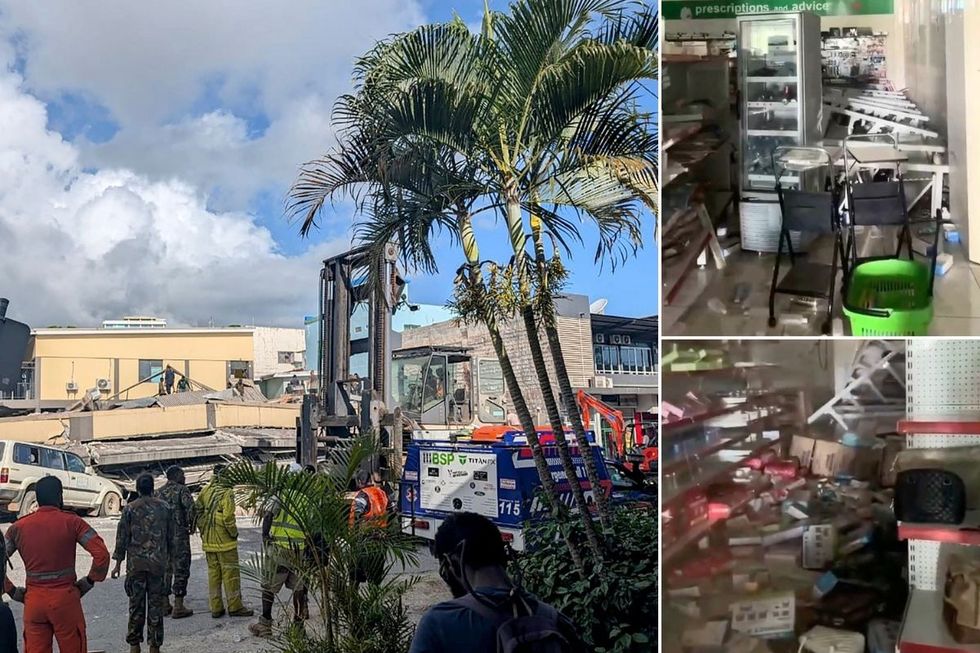A powerful 7.3-magnitude earthquake struck Vanuatu’s capital Port Vila on Tuesday, causing significant damage to buildings and sending injured residents to hospital.
The quake has caused “considerable damage” to diplomatic facilities, including a shared mission housing multiple nations’ embassies, whilst disrupting essential services across the capital.
Communications have been severely impacted, with phone lines and government websites down, though social media posts have begun revealing the extent of destruction in the Pacific island nation.
The Red Cross has reported significant damage through its workers on the ground, with footage showing injured people being transported to Vila Central Hospital on stretchers.

Massive 7.3 magnitude earthquake rocks Vanuatu as ‘considerable damage’ reported
GETTY/REUTERS
The earthquake struck 30km west of Port Vila at a depth of 57.1km, according to the US Geological Survey.
A magnitude 5.5 aftershock followed the initial tremor.
The US Tsunami Warning System initially issued a warning for the South Pacific nation, but this was later cancelled.
Professor Meghan Miller from the Australian National University explained that the quake hit a seismically active area.
“In this region, where the tectonic plates converge is one the world’s most seismically active plate boundaries,” she said.
The earthquake’s significant depth of 57km prevented a tsunami, though the island experienced “very strong shaking, likely resulting in moderate damage to structures,” Miller added
Dan McGarry, a journalist based in Port Vila, described it as “the most violent earthquake I’ve experienced in my 21 years living in Vanuatu and in the Pacific Islands.”
McGarry told the Associated Press he witnessed three people on gurneys “in obvious distress” outside the hospital.
Videos shared by the Vanuatu Broadcasting and Television Corporation showed crowds gathering outside Vila Central Hospital as injured residents were being transported on stretchers.
One social media video depicted crumpled buildings in the capital, including one that had collapsed onto cars.
Care Australia, a non-profit humanitarian agency, reported that many large buildings have collapsed in Port Vila.
Additional footage showed landslides blocking roads, whilst shops displayed scenes of destruction with items and shelves tumbled to the floor.
A building housing multiple diplomatic missions in Port Vila, including those of the United States, Britain, France and New Zealand, suffered significant damage in the quake.
The US embassy announced its immediate closure due to “considerable damage” to its mission, according to a statement from the country’s embassy in Papua New Guinea.
“The US embassy in Port Vila has sustained considerable damage and is closed until further notice,” the statement said. “Our thoughts are with everyone affected by this earthquake.”
New Zealand’s Foreign Ministry confirmed damage to the shared diplomatic facility and said officials were working to account for New Zealand High Commission staff.
Social media footage showed the diplomatic building with buckled windows and debris that had crumbled from walls onto the ground.
The ministry noted that 37 New Zealanders were registered as being in Vanuatu.
 Anthony AlbaneseGETTY
Anthony AlbaneseGETTYElectricity has been cut across Port Vila, with water supplies also disrupted in most of the capital.
The widespread infrastructure damage has prompted regional leaders to offer support.
Australian Prime Minister Anthony Albanese expressed solidarity with Vanuatu on social media platform X.
“Australians are thinking of our friends and neighbours in Vanuatu after the devastating earthquake that struck their home this afternoon,” Albanese said.
He added that Australia was “closely monitoring the situation and stand ready to assist the people of Vanuatu in any way we can.”
The earthquake has affected a nation of approximately 330,000 people spread across 80 islands.
Emergency services continue to assess the full extent of damage, though communications disruptions are hampering these efforts.